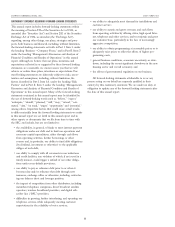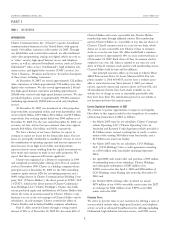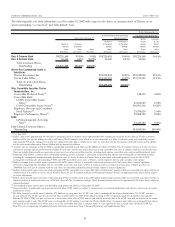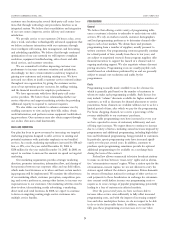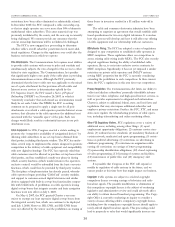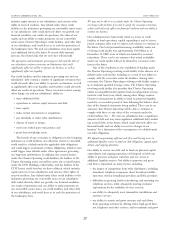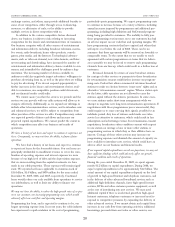Charter 2007 Annual Report Download - page 21
Download and view the complete annual report
Please find page 21 of the 2007 Charter annual report below. You can navigate through the pages in the report by either clicking on the pages listed below, or by using the keyword search tool below to find specific information within the annual report.
customers has had and is expected in the future to have an
adverse impact on our cash flow and operating margins. In order
to mitigate reductions of our operating margins due to rapidly
increasing programming costs, we continue to review our pricing
and programming packaging strategies, and we plan to continue
to migrate certain program services from our analog level of
service to our digital tiers. As we migrate our programming to
our digital tier packages, certain programming that was previ-
ously available to all of our customers via an analog signal may
only be part of an elective digital tier package offered to our
customers for an additional fee. As a result, we expect that the
customer base upon which we pay programming fees will
proportionately decrease, and the overall expense for providing
that service will also decrease. However, reductions in the size of
certain programming customer bases may result in the loss of
specific volume discount benefits.
We have programming contracts that have expired and
others that will expire at or before the end of 2008. We will seek
to renegotiate the terms of these agreements. There can be no
assurance that these agreements will be renewed on favorable or
comparable terms. To the extent that we are unable to reach
agreement with certain programmers on terms that we believe
are reasonable, we have been, and may in the future be, forced to
remove such programming channels from our line-up, which
may result in a loss of customers.
FRANCHISES
As of December 31, 2007, our systems operated pursuant to a
total of approximately 3,300 franchises, permits, and similar
authorizations issued by local and state governmental authorities.
Such governmental authorities often must approve a transfer to
another party. Most franchises are subject to termination pro-
ceedings in the event of a material breach. In addition, most
franchises require us to pay the granting authority a franchise fee
of up to 5.0% of revenues as defined in the various agreements,
which is the maximum amount that may be charged under the
applicable federal law. We are entitled to and generally do pass
this fee through to the customer.
Prior to the scheduled expiration of most franchises, we
generally initiate renewal proceedings with the granting authori-
ties. This process usually takes three years but can take a longer
period of time. The Communications Act of 1934, as amended
(the “Communications Act”), which is the primary federal statute
regulating interstate communications, provides for an orderly
franchise renewal process in which granting authorities may not
unreasonably withhold renewals. In connection with the fran-
chise renewal process, many governmental authorities require the
cable operator to make certain commitments, such as building
out certain of the franchise areas, customer service requirements,
and supporting and carrying public access channels. Historically
we have been able to renew our franchises without incurring
significant costs, although any particular franchise may not be
renewed on commercially favorable terms or otherwise. Our
failure to obtain renewals of our franchises, especially those in
the major metropolitan areas where we have the most customers,
could have a material adverse effect on our consolidated financial
condition, results of operations, or our liquidity, including our
ability to comply with our debt covenants. Approximately 15%
of our franchises, covering approximately 20% of our video
customers were expired at December 31, 2007. Approximately
7% of additional franchises, covering approximately 8% of addi-
tional video customers will expire on or before December 31,
2008, if not renewed prior to expiration. We expect to renew all
or substantially all of these franchises.
Proposals to streamline cable franchising recently have been
adopted at both the federal and state levels. These franchise
reforms are primarily intended to facilitate entry by new compet-
itors, particularly telephone companies, but they often include
substantive relief for incumbent cable operators, like us, as well.
In many states, the cumbersome local franchising process under
which we have historically operated has been replaced by a
streamlined state certification process. See “– Regulation and
Legislation – Video Services – Franchise Matters.”
Competition
We face competition in the areas of price, service offerings, and
service reliability. We compete with other providers of television
signals, high-speed Internet access, telephone services, and other
sources of home entertainment. We operate in a very competi-
tive business environment, which can adversely affect the result
of our business and operations. We cannot predict the impact on
us of broadband services offered by our competitors.
In terms of competition for customers, we view ourselves as
a member of the broadband communications industry, which
encompasses multi-channel video for television and related
broadband services, such as high-speed Internet, telephone, and
other interactive video services. In the broadband industry, our
principal competitor for video services throughout our territory is
DBS and our principal competitor for high-speed Internet ser-
vices is DSL provided by telephone companies. Our principal
competitors for telephone services are established telephone
companies and other carriers, including VoIP providers. Based on
telephone companies’ entry into video service and the upgrades
of their networks, they will become increasingly more significant
competitors for both high-speed Internet and video customers.
We do not consider other cable operators to be significant
competitors in our overall market, as overbuilds are infrequent
and geographically spotty (although in any particular market, a
cable operator overbuilder would likely be a significant compet-
itor at the local level).
Our key competitors include:
DBS
Direct broadcast satellite is a significant competitor to cable
systems. The DBS industry has grown rapidly over the last
several years, and now serves more than 27 million subscribers
nationwide. DBS service allows the subscriber to receive video
services directly via satellite using a dish antenna.
Video compression technology and high powered satellites
allow DBS providers to offer more than 200 digital channels
from a single satellite, thereby surpassing the traditional analog
CHARTER COMMUNICATIONS, INC. 2007 FORM 10-K
10


